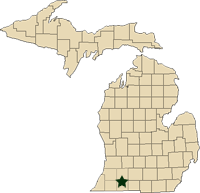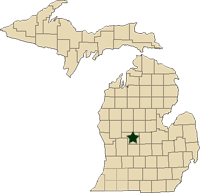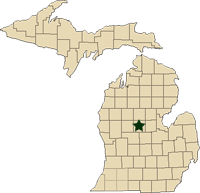Regional reports on Michigan field crops – August 9, 2012
MSU Extension educators’ pest and field crop updates for Michigan.
This week’s regional reports:
- Southwest Michigan – Bruce MacKellar
- West Central Michigan – Fred Springborn
- Central Michigan – Paul Gross
Southwest Michigan – Bruce MacKellar, Michigan State University Extension
|
Sometimes when we are in a drought year, it seems nearly impossible for rain to fall in your area no matter what the percent chance of precipitation is in the forecast, how large the storms are or how close the storms may come to the farm. Thankfully, those extremely dry areas are much smaller than they were two weeks ago, but they still exist across southwest Michigan. With the best chance for rain that we have seen much of the summer in the near term forecast, many areas have yet to see much more than trace of precipitation amounts. Repeated periods of drought stress continue to take their toll on corn and soybean yield potential, especially across these “missed” portions of the region.
Crop report
Commercial corn fields are progressing towards maturity quite quickly where adequate moisture is available for growth. Early planted fields are approaching the dent stage under irrigation. In other areas, growth and development has been slowed again by moderate to severe drought conditions. This has particularly hit the later-planted corn hard, most of which was just beginning pollination as the second round of hot, dry conditions hit. Earlier-planted corn had been in the grain fill stages, which will most likely mean that ears will suffer further damage in the form of aborted kernels and lower test weights. Overall, even the portions of fields that were on track for better production will most likely be impacted by the latest dry spell. This all depends on the amount of rainfall the area received over the last two weeks.
On the pest management side, some folks are struggling with the decision of whether to spray commercial corn for spider mites. Some of the irrigated fields are exhibiting at least some damage up to the ear leaves. Most the fields that I have seen are approaching the dent stage of development with a good amount of green leaves remaining on the plants. In visiting with MSU entomologist Christina DiFonzo, we both believe that the threat of reduced yields at this stage of the season is pretty minimal. The other consideration is that the fields are essentially so tall that even high-boy ground rigs may pose a challenge for spraying those fields without causing some lodging.
For dry land commercial corn, growers would have to evaluate the yield potential, the developmental stage of the corn, the infestation level of the mites and the amount of leaf damage present and the height in the canopy to make a decision. Most fields I have walked do not appear to have enough damage or active mite populations to warrant a treatment. Producers might want to focus their activities on controlling spider mites in soybean fields.
Western bean cutworm egglaying was much reduced in fields that I have walked compared to 2011. Incidence of leaf diseases in field corn, even heavily irrigated fields, are much lower than in than in the last several years.
We are rapidly going to reach the time period where drought-damaged fields will need to be evaluated for yield potential. With feed anticipated to be in short supply this winter, some fields with no ears or with limited yield potential might be better harvested as silage. This decision takes a lot of field crop producers out of their comfort zone. For more information on exploring your options, including how to approach reaching agreement with valuation with livestock producers, harvesting and storage considerations for these materials and more, visit the MSU Extension Drought Resources for Field Crops website.
Seed corn fields also have spider mite challenges. The challenge with seed fields is that we remove so much of the leaf volume with the de-tasseling operation that it is much more critical to keep the remaining leaves healthy. There is also some concern that insecticides used to control corn earworms and western bean cutworms may have actually flared mite populations. In either case, the decision to control mites is much easier on seed corn. Watch for stippling on the leaves and be prepared to keep the leaves protected, especially if the seed corn has just been pollinating. Fields I walked in Cass County had very low mite populations; fields in northern St. Joseph and Southern Kalamazoo counties had much higher incidence of mites. As always, check with your company pest manager before treating seed corn fields.
Soybeans continue to be the “battleground” crop across southwest Michigan. Where rains fell, the crop has responded nicely to the improved growing conditions. Where the conditions were dry, soybeans have struggled to grow and yields are going to be greatly impacted. In addition, the dry areas have been inundated with spider mite infestations. This has also spread to the region’s irrigated soybean fields and even some areas where the rainfall has been a bit more consistent, like southern Berrien County. Lots of acres have been treated for spider mite infestations; a surprising amount have needed more than one treatment.
Rainfall is what we really need to help with this problem. In a recent conversation with MSU Extension soybean educator Mike Staton, he said he had read that relative humidities above 90 percent for 18 to 24 hours, accompanied by temperatures below 85 F for an extended period can really help to jumpstart the pathogenic fungi within two to three days. DiFonzo said that infested corn leaves she had placed in a plastic bag overnight triggered fungi infections in spider mites. Let’s hope the meteorologists can come through with their predictions of rainfall across the region to reduce the challenges from the mites.
In irrigated soybeans, incidence of white mold is low, which is really good. Dry land soybeans have varying degrees of weed infestations due primarily to the drought-stressed plants failing to provide early canopy closure. We should be ready to evaluate fields for other problems such as soybean cyst nematode infestations and sudden death syndrome in the two weeks before senescence later in the month.
Alfalfa had really improved following the rains on July 20. Depending on the rainfall totals in your area, growth has either been good or has dropped off substantially over the last week to 10 days. Needless to say, hay is going to be in short supply this year across the region. We are getting all kinds of questions about feed value of well dried, over-mature grasses.
West Central Michigan – Fred Springborn, Michigan State University Extension
|
Weather
Generally dry weather across the west central region this week. Isolated rain and thundershowers did occur over the past several days, giving moisture and in one instance hail to localized areas. High air temperatures were in the mid-80s with lows in the lower 50s to mid-60s.
Crops
Corn is showing drought stress this week in several areas in the west central region. By-in-large the crop remains in fair condition overall with the poorest corn on the southern edge of the region. Spider mites are present in many fields low in the canopy and generally at levels that are not treatable. Low levels of leaf rust have been observed. Japanese beetles continue to be present in corn.
In soybeans, spider mites are present in several fields; some populations are active and some are not active. White mold is present, but is not a major issue this year. Japanese beetles are present and annoying, but low levels in many fields. Soybean aphid levels remain very low.
Oat harvest is generally complete
The first two weeks of August are the optimal time to treat dry beans for western bean cutworm this year. Western bean cutworm pheromone traps continue to catch one or so moths per night. The end of flight is near – we are well past peak flight. A few fields do have some spider mite infestation on field margins. Potato leafhoppers continue to be present in many locations. Japanese beetles are also feeding in many fields at below threshold levels.
Alfalfa harvest continues with many producers finishing third cutting. Many growers will have an opportunity to put up a high quality cutting this month, but are still very short on quantity.
Potato leafhopper adults and nymphs continue to be present. Numbers are variable and generally down from two weeks ago, but I still find fields where this pest is at, near, or above threshold levels. This pest still needs to be scouted for in both alfalfa and dry beans.
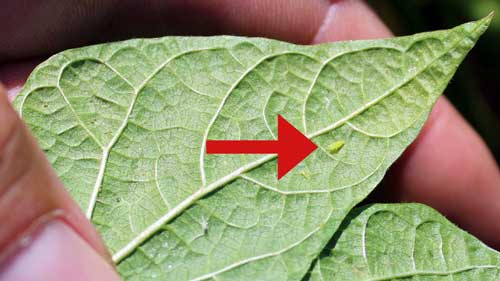
Potato leafhopper on
the underside of a bean leaf in Bay County.
Photo credit: Fred Springborn, MSUE
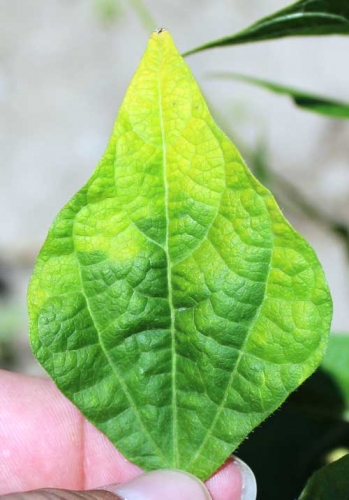
Yellowing of bean
leaf due to hopper burn.
Photo credit: Fred Springborn, MSUE
Keep spider mites in mind when considering insecticide applications for other pests as insecticide applications such as pyrethroids can increase spider mite damage. Spider mite continues to be active in many areas in several fields and in various crops, in some cases the population has crashed due to natural predation or disease.
Central Michigan – Paul Gross, Michigan State University Extension
|
Weather
The central region has been receiving just-in-time rains most of the summer. These rains have kept the crops growing, but not enough to build any reserve. Dry conditions for the last week have stressed crops at a critical point in the growing season. Crops are showing signs of drought stress, especially corn. Rains on Thursday (August 9) and forecasts of cooler, wetter conditions for the next week should provide relief and allow crops to progress more normally.
Commodity reports
The corn crop in the region is continuing to progress with early planted fields in the dent stage. Yield prospects vary widely with some reporting average to above average expected yields and others are reporting well below average expectations. The concern is how well the crop pollinated. Some fields have been observed that pollination was poor and the expected yields will be well below 100 bushels per acre. There are reports of mites in many corn fields. Treating for this pest is not recommended. Western bean cutworm populations are low compared to other years.
The August rains are a bright spot for soybeans. The crop is progressing nicely with most expecting average or better yields. Many fields are continuing to flower and set new pods on the top of the plants. On the insect side, spider mites are the big story. A large number of fields have been treated for this pest. Continue to scout fields. Japanese beetle numbers are higher than normal in many fields. While the leaf feeding looks bad, no fields have populations high enough to treat.
Double crop soybeans are just beginning to flower and are now taller than the wheat stubble. Herbicide applications are being made. Most are optimistic this was a profitable decision.
Harvest of third cutting alfalfa has been completed and the regrowth is looking good. Yields were down considerably. Potato leafhoppers have severely damaged fields when left uncontrolled. Continue to scout for this pest. Summer alfalfa seeding is being planted this week.
Many wheat fields are being used for double crop soybeans or emergency forage. Consider planting a cover crop on these acres. Farmers are advised to manage weeds in these fields as well.
Oat harvest is completed with most reporting better than expected yields.
Dry beans are setting pods and progressing. There is concern about pod set during the high temperatures. Many are reporting the heat knocked off the early flowers. Insecticide applications for potato leafhoppers and western bean cutworms are being made.
The sugarbeet crop is on pace for record yields. Scout fields for disease.



 Print
Print Email
Email